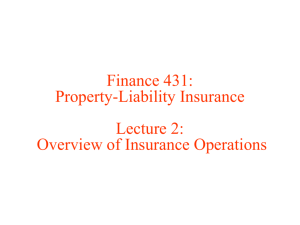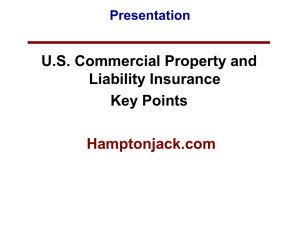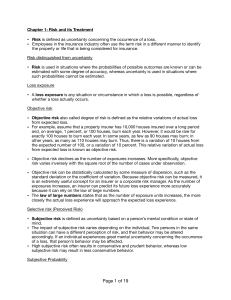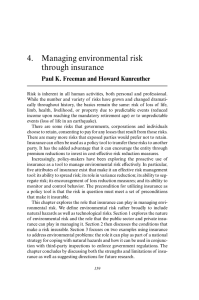Property and Casualty Insurance
advertisement
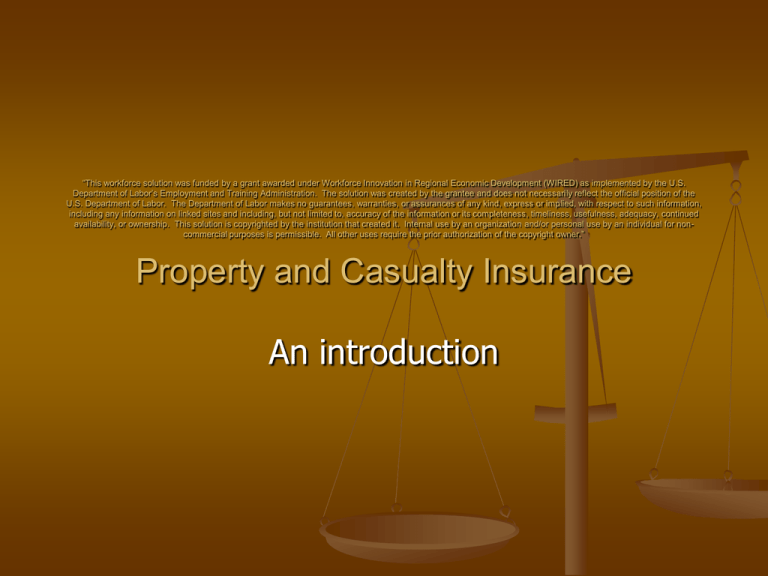
“This workforce solution was funded by a grant awarded under Workforce Innovation in Regional Economic Development (WIRED) as implemented by the U.S. Department of Labor’s Employment and Training Administration. The solution was created by the grantee and does not necessarily reflect the official position of the U.S. Department of Labor. The Department of Labor makes no guarantees, warranties, or assurances of any kind, express or implied, with respect to such information, including any information on linked sites and including, but not limited to, accuracy of the information or its completeness, timeliness, usefulness, adequacy, continued availability, or ownership. This solution is copyrighted by the institution that created it. Internal use by an organization and/or personal use by an individual for noncommercial purposes is permissible. All other uses require the prior authorization of the copyright owner.” Property and Casualty Insurance An introduction Basic Insurance Concepts Insurance is a mechanism by which risk is transferred by a person or business to an insurer. The insurer reimburses the insured for covered losses and provides for the sharing of losses among all insureds. Basic Insurance Concepts This sharing is possible because the insurer collects a pool of all of the “premiums” paid by customers into a fund from which it pays losses. The insurer mechanism, therefore, includes three essential components: a) Risk, b) Transfer, c) Pooling. Basic Insurance Concepts Risk: The uncertainty about outcomes, some some of which can be negative. Transfer: A risk financing technique by which the financial responsability for losses and variability is shifted to another party. Pooling: An arrengement that facilitates the grouping together of loss exposures and the resources to pay for any losses that may occur. Types of Insurance Policies Insurance Policy: A contract that states the agreement between and the rights and duties of the insurer and the insured. The types of property-casualty insurance policies fall into two categories: Personal insurance policies Commercial insurance policies Personal Insurance Policies These are the most common types of personal insurance policies: Homeowners Personal auto Personal watercraft Personal umbrella Personal Insurance Policies Are designed to cover personal loss exposures such as those that arise from buildings, personal property (including contents of the home), physical damage to vehicles, and legal liability arising from the ownership of a home, vehicles, or watercraft as well as the activities of the individual and families. Personal Insurance Policies Legal Liability: The legally enforceable obligation of a person or an organization to pay a sum of money (called damages) to another person or organization. Collision: Damage to a motor vehicle caused by its impact with another vehicle or object, or by the vehicle’s overturn. Commercial Insurance Policies These are examples of commercial insurance policies: Commercial property Commercial crime Employee dishonesty Commercial general liability Commercial auto Workers compensation Commercial umbrella Commercial Insurance Policies A commercial property policy includes coverage for damage to buildings or contents that results from fire, vandalism, and other causes of loss. Commercial General Liability (CGL) coverage is also needed to protect the insured against claims that arise from legal legal liability for bodily injury to others and for damage to the property of others. How Insurance Benefits Society The insurance industry provides individuals and businesses with many benefits. The primary benefit is that, through insurance, individuals and businesses are reimbursed for the cost of covered losses. This loss payment allows individuals and families to recover quickly and businesses to continue operations. How Insurance Benefits Society A related benefit is that uncertainty about potential future losses is reduced. Other benefits of insurance include using resources efficiently, promoting loss control, satisfying legal requirements, and providing a basis for credit. Premium Allocation Insurers allocate the premiums they collect to pay losses and to pay expenses. Premium dollars that are not immediately needed for losses or expenses are invested. Premium Allocation Insurers collect millions of dollars of premium each year for the policies they issue to customers. Insurers allocate these premium dollars in three principal ways: Pay Claims Pay Expenses Investments The Insurance Transaction An insurance transaction occurs when a a customer purchases insurance either directly from a insurer or through a “producer”. Producer: A person who sells insurance products for one or more insurers. The Insurance Transaction Most insurance transactions involve at least two parties: an insured (policyholder) and an insurance company, or insurer. Many other insurance transactions may include a third party, the producer. Producers are involved in the sale of insurance products and include sales representatives, agents, and brokers. Insurer Functions Insurers perform many functions to provide products and services to their customers. Insurers sell insurance policies and pay claims as required by those policies, but they do much more. They perform multiple key functions in order to accomplish their goal of protecting their customers while earning a profit. Insurer Functions These functions are: Marketing Underwriting Claims Loss Control Premium audit Insurance Regulation Insurers are regulated primarily for three reasons: To protect customers To maintain insurer solvency To prevent destructive competition Insurance Regulation Insurance regulation focuses primarily on five key areas: Licensing Insurance rates Insurance policies Market conduct Insurer solvency





